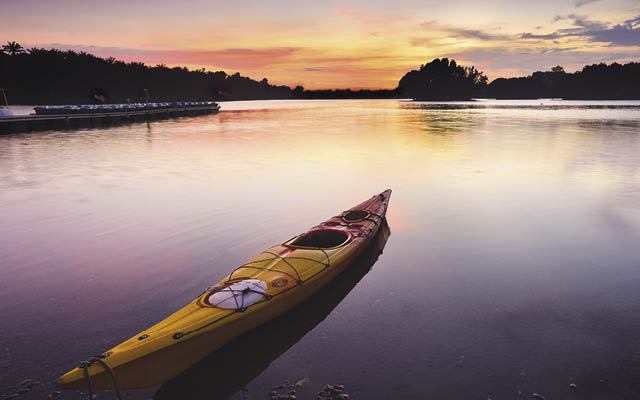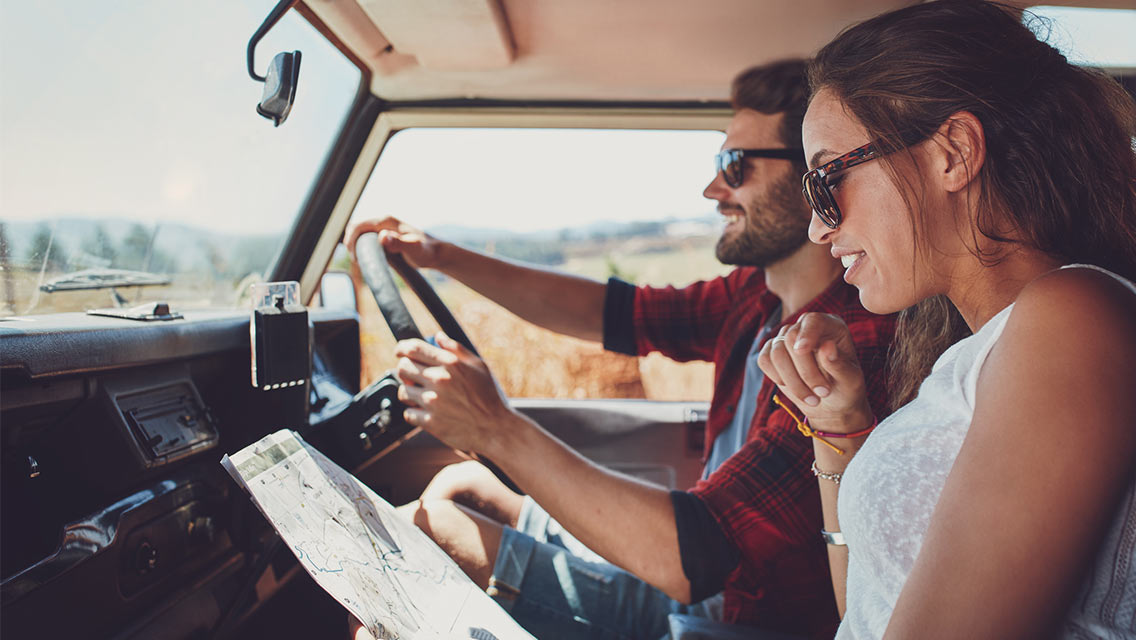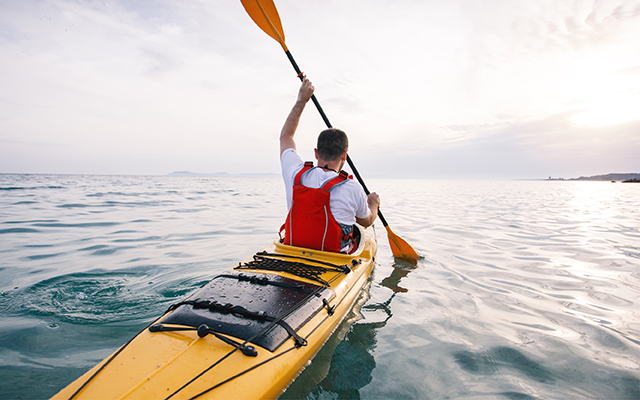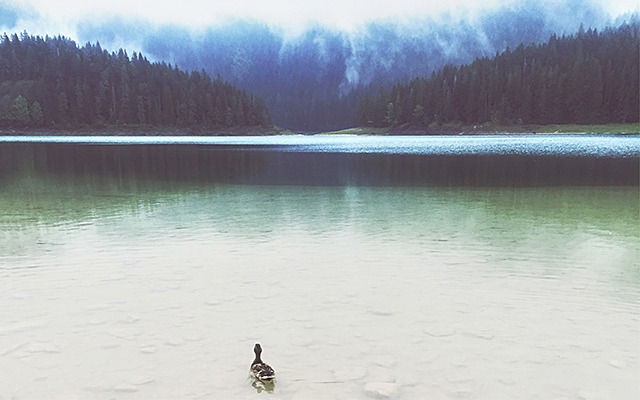Take a deep breath, and go.
Bobbing in a kayak in the middle of Salo Lake in northern Minnesota, I find that these simple directions are easier said than done.
My fellow kayakers and I — six women in our 30s, 40s, and 50s — have been practicing wet exits and self-rescues all day under the tutelage of our instructor, Kathleen Anderson, who has quite literally led us into the wild to discover our own wildness. These are crucial safety drills for anyone interested in sea kayaking, particularly solo jaunts. I’m up next, the last of the group, and I’m frozen to my seat.
Fear pulses through me — primarily the fear that if I flip over, I will be stuck underwater. Lifelong nightmares (of flipping over, of being trapped, of drowning) surge to the surface of my consciousness.
I know that I should be just fine. I know that I will take a deep breath, shift my weight to one side until I capsize, slip out of the kayak with my paddle still in hand, and rise to the surface, where more oxygen is waiting. I will then right my kayak and commence the self-rescue. (Self-rescue, I muse to myself as the rest of my group waits, the late-summer sun lazily descending in the sky, has to be the most empowering phrase in the history of phrasing.)
I know all of this to be true because I’ve seen the other women each complete a successful wet exit and self-rescue. I know this to be true because Anderson, a renowned expert on kayaking, has told me so. I know I’ll be fine.
And yet I can’t help but think: Maybe I don’t really need to learn how to kayak in open water. Maybe solo kayaking is simply not for me. Maybe it’s an experience I’ll be perfectly happy never having.
Salo Lake, one of northern Minnesota’s abundant freshwater pools, is breathtaking. Loons croon near a jungle of lily pads while eagles soar overhead. Little bloop sounds announce playful otters ruffling the glassy top of the lake. The water is calm, a far cry from the oceanic currents of Lake Superior just a short drive to the east. The surface reflects the blue of the sky and green-and-gold tips of the trees, unique specimens of the Boreal forest found only this close to Canada.
I feel my weight in the kayak, and it occurs to me that I’m not simply bobbing on the surface of the water — I’m sitting in it. My hips, my center of gravity, the root of my body, are below water level. It feels magical.
Ready or not, I take a deep breath, allowing the oxygen to fill my lungs deeply, down and back and out to the sides of my body. I shift my weight and suddenly I’m underwater. But I’m not stuck. My legs slip out of the kayak, and I make my way to the surface. Oxygen is, indeed, waiting for me.
My paddle, though. I’ve lost my paddle.
Up for the Challenge
Humans have been kayaking for millennia. Like other vessels designed to traverse rivers, lakes, seas, and oceans, kayaks helped our species become water-faring, changing our destiny as explorers by opening up neighboring regions and faraway lands.
While voyageurs once paddled into unknown waters to corner trade routes and seek out sustenance, modern-day kayaking enthusiasts like me are traveling existing courses largely out of a desire for adventure and self-discovery.
Some people kayak whitewater in rough, rocky rivers, which call for short boats that can make quick turns and navigate treacherous currents. Others are drawn to leisurely paddling longer distances in lakes and seas. Sea kayaks are typically longer vessels, making it easier to track a straight line.
Both river riding and sea kayaking provide great full-body workouts and immense potential for an adrenaline rush. Both also carry risks; the right gear, technique, and safety precautions are all critical for success and enjoyment.
I knew all of this and then some when I registered for this retreat, but knowing facts in my head is very different from knowing the essence of something in my heart and bones. So, when the opportunity arose to experience sea kayaking for the first time in one of my very favorite places, Minnesota’s North Shore region, I was tempted.
I’d mostly avoided kayaking out of fear and discomfort. I love the water and have become a standup-paddleboarding aficionado in recent years. The thought of kayaking, however, made me feel trapped and prone to drowning. Moreover, a tricky lower-back issue made me hesitate to commit to a seated position for hours on end, with no opportunity to stand or stretch.
At the same time, I pride myself on a willingness to embrace challenges, which tend to be more mental than physical for me. And I love northern Minnesota, which I have come to consider a sort of spiritual home — perhaps harking back to memories of my early childhood in lake-filled Sweden. To see the lake from a different angle, experiencing it from within the water instead of standing on the shore, was appealing.
The clincher was knowing that the excursion would be led by Anderson, owner of Wintermoon Summersun, a 400-acre eco-friendly homestead and adventure-retreat lodge featuring dogsledding and sea kayaking in Brimson, Minn.
Anderson had taught me to run sled dogs in Superior National Forest. Strong, firm, and gentle, she spoke a language of wildness that made sense to me. I found success and growth in the experience, not to mention a new appreciation of the deep woods in deepest winter. (To read about my dogsledding adventure, visit “Pulling Ahead: Dogsledding Adventures.”) What unknown magic did summer waters hold that Anderson could help me unlock?
Two weeks later, carrying my water shoes and deep-seated fears, I returned to Wintermoon Summersun to find out.
Welcoming Novelty, Embracing Risk
Anderson’s retreat lodge caters almost exclusively to female-identifying participants, not because kayaking, dogsledding, or any of the other lessons imparted there are for women only. Rather, the place is imbued with an energy that insists that being outdoors — communing with nature, reckoning with rough water and energetic dogs, simply being wild — is for women and nonbinary folks too.
Those who came together for this retreat varied in age, background, and kayaking experience. Each day followed a predictable schedule: walking and watering Anderson’s sled dogs; yoga designed with kayakers in mind, mobilizing our wrists, shoulders, and hips for a day of paddling; breakfast; kayaking instruction; lunch; kayaking on nearby lakes; dinner for the dogs; dinner for us; and a campfire.
Despite the routine, every day offered a unique experience. Like the calm waters that we kayaked for hours, our days were at once the same and different, following a predictable pattern that created space for novelty and the opportunity to embrace risk.
The biggest risk for me was the wet exit: willingly submerging myself to simulate capsizing so that if (honestly, when) it happens in real life, the shock won’t prevent me from rescuing myself.
I made some missteps: I didn’t tie back my hair, so I emerged with my face covered and thought momentarily, if irrationally, that I’d lost my eyesight. In the excitement, I also let go of my paddle, a vital tool in the self-rescue process.
In a real-life situation, in more precarious waters, I could’ve lost the paddle altogether; in colder water, the wasted time chasing it could’ve meant hypothermia. Luckily, the water was calm and warmed by the summer sun, meaning the consequences were minimal. And I learned my lesson to never let go.
Once I’d swum to my paddle, which hadn’t floated far, I was safely and swiftly able to right the kayak, slip the preinflated flotation device onto one of the paddle blades, anchor the other blade atop the vessel, and use the paddle handle as a stable surface to lift myself out of the water and get back into the boat. I’d never felt prouder.
From that point on, I was more confident and joyful with every outing. When I wasn’t worried about the impending doom of capsizing, I realized all there was to enjoy. I didn’t drown, and my back never acted up — the things I’d feared never came to pass. In their place, I developed new skills and discovered a new depth to my own strength.
A habit I have, especially in charged moments, is to open a random book to a random page. The first night of the retreat, I’d nervously thumbed a book on Anderson’s coffee table. I opened it to an Edmund Carpenter poem called “Eskimo Song,” which sums up the trip. I’ve carried it close to my heart ever since:
And I think over again
My small adventures
When with a shore wind I drifted out
In my kayak
And thought I was in danger.
My fears,
Those small ones
That I thought so big,
For all the vital things
I had to get and to reach.
And yet, there is only
One great thing,
The only thing:
To live to see in huts and on journeys
The great day that dawns,
And the light that fills the world.




This Post Has 0 Comments